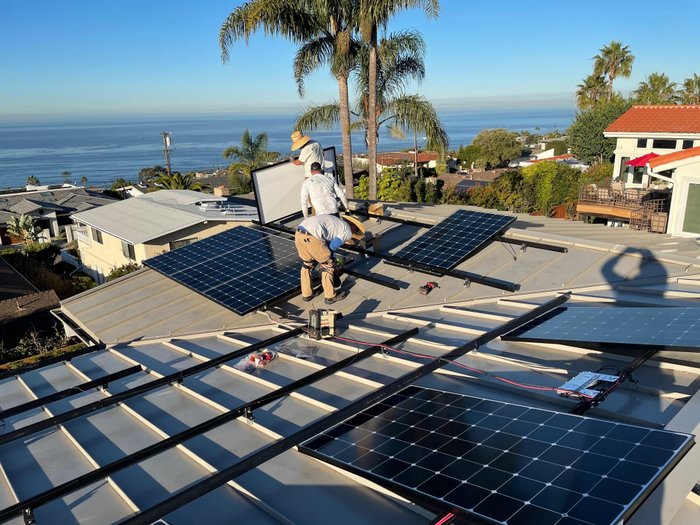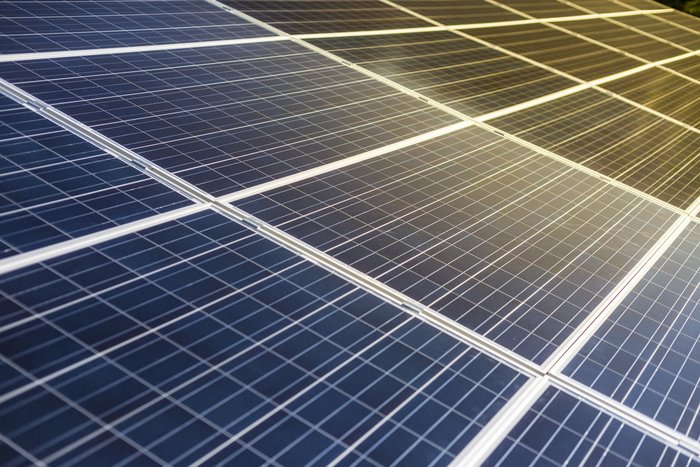Case study: California home adds 68-kWh of storage capacity in massive PV system upgrade

Since 2019 when PG&E enacted the Public Safety Power Shutoff program, California’s aging electrical grid has become so unstable that many California homeowners regularly lose power for extended periods. The idyllic area of La Jolla, near San Diego, is no exception to the outages. Santa Ana winds in February 2021 caused one of the many recent outages in this area — outages that can last for days. Many homeowners are powerless to protect themselves against these outages — but those who have the means are adding backup power systems to their homes. While generators are often the first backup solution that comes to mind, solar plus storage systems are quickly becoming a popular solution for energy-insecure homeowners.
The Install
One homeowner in La Jolla asked Allied Energy Inc. to design a solution that would back up an entire 3,500-square-foot home equipped with four air conditioning unit compressors and a large swimming pool. The system would need to meet code requirements for the home’s location in an earthquake zone, and it had to help mitigate energy costs, despite the area’s tiered time-of-use (TOU) rates, all while staying on budget. The solution: a robust solar plus storage system.
“This install was particularly interesting because of the sheer magnitude of what the homeowner needed to have backed up,” said Simon Allan, president of Allied Energy. “The homeowner was [uncertain] about how much backup power they wanted in the beginning, so as we got further into the design, we needed to accommodate a much larger load than we’d originally planned for.”
Despite shifting goalposts, Allied Energy’s professional team was able to design and install a system that met the customer’s significant energy needs. The system design required two 200-amp automatic transfer switches (ATSs), two 7.6 kW inverters and four Generac PWRcell batteries for a total of 68 kWh of energy storage capacity – enough to run the average American home for over two days without sunshine or grid power. Due to the uncommon scale of this installation, the project took over two weeks to complete. For comparison, a typical PWRcell installation can be completed in one to two days.
One of the challenges that Simon’s team had to overcome was the unique arrangement of the home’s electrical panels.
The home features a giant 400-amp service panel, twice the typical size, feeding two 200-amp sub-panels, each located at opposite ends of the home. Usually, this would mean installers would have to cut into the drywall and re-route a sub-set of the home’s existing circuits into additional sub-panels for partial home backup, a task that could balloon project cost and complexity while reducing performance. However, PWRcell’s installer-friendly architecture and whole-home backup capability, Allied Energy was able to integrate the system without the need for any major remodeling and renovation, keeping the installation on schedule and under budget.
Over the years, technologies like car engines and mobile devices have seen massive increases in performance. Thanks to optimizations and advances, the technology we use today is smaller and more powerful now than ever before. Home energy storage, however, is a relatively new technology and performance-enhancing technologies are not yet commonplace. With most solar plus storage platforms, the only way to protect more loads is by adding more battery storage, which can quickly double or triple project costs. Allied Energy selected the PWRcell system for this project because of its size and load management capabilities that allow for a relatively small amount of battery storage to perform like a much larger battery system, protecting more loads and extending backup power over a longer period of time.
California State of Mind

For the average homeowner, it may appear that installing a solar plus storage system is out of reach. However, homeowners should consider long-term value, benefits, and rewards in their calculus – particularly in California.
Solar plus storage installations are heavily incentivized by both state and federal governments. The Self Generation Incentive Program (SGIP) offered by the California Public Utilities Commission (CPUC) can incentivize qualified homeowners to install batteries along with their solar energy systems. Another significant savings: the federal government offers a tax credit to the tune of 22% of the total project cost in 2021.
Many California utilities feature a tiered rate structure, charging different amounts for energy based on the time of day that energy was used. This is called time-of-use, or TOU billing. Homeowners are charged a higher rate during peak demand hours and lower rates during off-peak hours. This system provides a financial incentive for homeowners to shift their energy consumption habits to off-peak hours by penalizing consumption during the evening.
For the homeowner in La Jolla, it was incredibly important for the system installed to mitigate the local TOU rates and lower their average monthly electricity bill from $2,000. A solar plus storage solution allowed the homeowner to mitigate the TOU rates by using stored energy during peak hours. After two months of operation, the homeowner is already beginning to see a reduction in their electric bill.
“Most people install solar to offset energy through PV production off of the roof and achieve net-zero over the year,” said Allan. “The battery has major benefits for offsetting time-of-use rates, and at the end of the day, homeowners just want to have power during a power outage.”
As the power grid continues to age and extreme weather events like wildfires continue to pose a threat to homes, it is becoming more evident that homeowners need energy security; especially now that families spend more time at home than ever. Solar plus storage solutions have evolved in recent years and are now scalable to supply power to an entire home. For the homeowner in La Jolla, even with a 3,500-square-foot home, a solar plus storage system provided the energy security and cost savings necessary to free themselves from the threat of power outages and rising energy bills.
Jeremy Niles is Channel Marketing Manager at Generac.





California has seen a great improvement when it comes to solar panels and battery storage installation. The big thing however is when it comes to dangerous weather such as fires, heavy winds, etc, power outages are prone to happen.
That is why California home owners should have solar panels and battery storage such as Tesla Powerwall as it will not only allow you to stay powered during power outages, but lower your electric bill while helping the environment.
Now is the time to go Solar + Battery Storage before the supply starts to slow down. With the chip issue currently, battery storage units may slow down in supply.